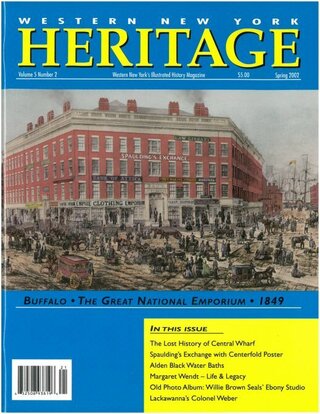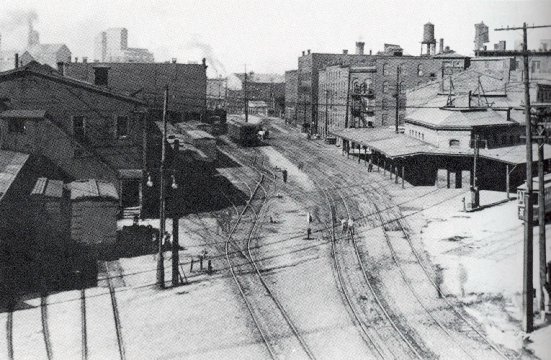
RAILROAD TRACKS: A 1909 photograph of tracks and sidings in Prime Street and on the site of the demolished Hazard Block.
Courtesy Ronald Dukarm and Harvey Holzworth
(This is the third part of a three-part story. It is preceded by Part I and Part II.)
The 800-page transcript of the trial and appeal preserves the testimony of a cross-section of the people who were participants in the continually evolving history of the Central Wharf. It provides valuable detailed information about the functioning of the wharf that would otherwise have been lost. The list of witnesses included: John B. Manning; Jewett M. Richmond, who had offices next to the Board of Trade; Edward Borr, a drayman who did carting with horse teams on the wharf in the 1840s; Alexander McMaster, a steamboat inspector; John Green, a tugboat captain; Alexander Sloan, who had been on the Wharf as early as 1835 as a boy of 15 years; Harvey Peek, a hotelman in the City since 1835; William Flemming, a forwarder; Niles Case, a canal boatman all his life; William H. Clark, a baker who delivered bread, biscuits and crackers all along the wharfs (from the still extant Mugridge Bakery building); Hiram H. Smith, a ship broker; Benjamin Bruce, a teamster; and Benjamin Bidwell of the Bidwell and Banta Co. shipbuilders. From their testimony a picture of the tumultuous activity at the Central Wharf emerges that is so rich in “local color” – the sights, sounds, smells and motions of daily waterfront life – that it defies comprehension.
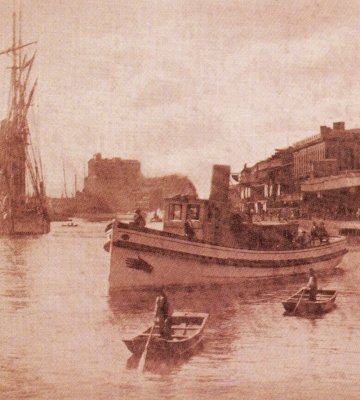
BUFFALO WATERFRONT c.1870: This C.L. Pond photograph shows a tugboat with the "Hand" emblem on its bow maneuvering in the Buffalo River. The buildings on the Central Wharf are visible at the right. A tall-masted sailing vessel stands opposite the Wharf.
Courtesy Dale Rossi
During the summer season all manner of vessels could be seen loading and unloading at the Central Wharf throughout the day and night. Barrels of flour, produce and “high wines” were often staked four-high along the dock. The Watson Fox firm located in the Hollister Brothers “Chequered Warehouse” at the east corner of the Prime Slip ran a fleet of fast sailing cargo brigs and schooners called “Buffalo Clippers.” The distinctive building gaudily painted in a checkerboard pattern was one of several that housed ship chandleries on the wharf. Sidewheel steamboats, including the palatial City of Buffalo and the Western Metropolis landed and departed from the foot of Main and Commercial Streets. Later, they were augmented by the stream “propellers” with their characteristic arched truss sides. A fleet of steam tugboats docked along the wharf at the foot of Main Street. The water taxis of the day were the famous Buffalo River ferryboats, little flat-bottomed punts propelled by the ferryman who stood on the stern wiggling a tiller-oar. It was said that these little ferries “gathered like flies” all along the Central Wharf. Canal boats were towed out of the Commercial Slip to be loaded and unloaded at the Central Wharf. The coming and going was continuous.
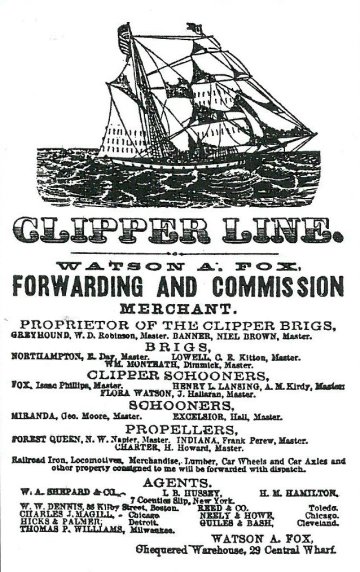
BUFFALO CLIPPER BRIG: 1850s advertisement for the Watson Fox firm located in the picturesque wharf's "chequered warehouse."
There were idlers and curiosity seekers there. Young boys and men alike went sightseeing there to be entertained by the noise and activity, listening to the shouts of sailors and wharf men operating creaking hoists and winches, skidding barrels and loading them onto long-tailed dray carts and horse-drawn wagons of every description. The background noise was regularly punctuated by steam whistles, ship bells and the tooting of the canal boatman’s horn.
Central Wharf was the great meeting place in the city. According to Jewett Richmond, “Central Wharf was a place that was very much, to a large extent, visited by people who were in town, happening to be passing through town.” It was known as the place to go to find out who was in town. Bankers would be down there trying to collect on loans. Some men walked the wharf for exercise to warm up at the beginning of the work day while surveying the scene. People would often congregate on the wharf and its balconies to celebrate the arrival and departure of the passenger steamboats. Colorful horse-drawn omnibuses regularly conveyed hotel guest to and from the steamboat dock in front of the Hazard Block. Others arrived in the one-horse Buffalo cab with its driver perched on top of the box. On the stern deck of the steamboats there was usually a little band of musicians playing tunes of the day, accompanying the bells and whistles, as the vessel departed the dock on its westward adventure.
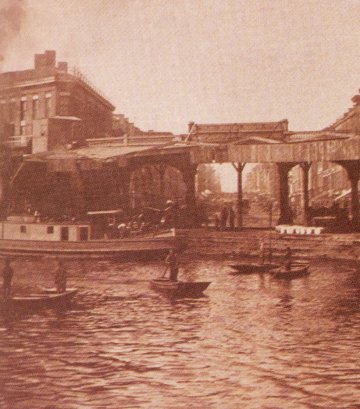
STEAMBOAT DOCK: The covered passenger steamboat dock at the foot of Main Street, seen from the water, with the Hazard Block visible at the left. The little one-man tiller-driven ferry boats were as ubiquitous on the Buffalo waterfront as gondoliers in Venice. Attributed to C.L. Pond c.1870.
Courtesy Dale Rossi
The heyday of the Central Wharf was also that of the great flood of westward migration on the lakes to Michigan, Wisconsin, Indiana and Illinois. Barton Atkins in his “Modern Antiquities” said: “The wharves at Buffalo, from the opening to the close of navigation, were crowded with these people, packing their household goods, farm implements, farm animals and themselves on board steamboats bound for new homes in the productive West.”
Others told of seeing pyramids of immigrant baggage piled up high on each end of the Wharf. Besides those that arrived by the Erie Canal there were those that arrived by land in the big lumbering covered freight wagons called Conestoga Wagons. These “prairie schooners” were a common sight on the Central Wharf. According to the testimony of William H. Clark, they came down Main Street right onto the dock where they were disassembled and loaded directly onto the steamboats. “There wasn’t a boat that went out for the upper lakes but what would have from two to four aboard.”
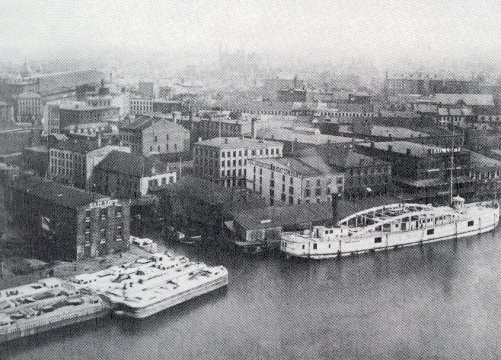
COMMERCIAL SLIP: A Bliss 1870s photo of the Commercial Slip end of the Central Wharf, probably taken from the Watson Elevator observation deck. An arch-trussed "propeller" steamboat is at the Wharf. Rafted canal barges stand off the Townsend & Coit building marked "Sail Loft."
Courtesy the Buffalo and Erie County Public Library
The eyewitness account of Harvey Peek who came to Buffalo in the 1830s confirms the scene in his own words: “The [canal] boats used to bring emigrants, and the emigrants were unloaded and they would lay around the docks some days. They used to come from Germany and anywhere else. There was a good deal of this emigration business in those early days. Hundreds of them lying around there all night sleeping there on their luggage.These emigrants I speak of were foreigners, and came up on the canal boats. There were a great many emigrant wagons that came from Vermont and Massachusetts, and those were usually those that came in their own conveyances. They were covered wagons, covered with canvas, and they had all their belongings in them. They would drive onto the dock and take the wagons to pieces and put them aboard the boats when they got ready for them, take them apart just as fast as they could make room for them all. You would see it every day during the summer months, the time the lake was open.”
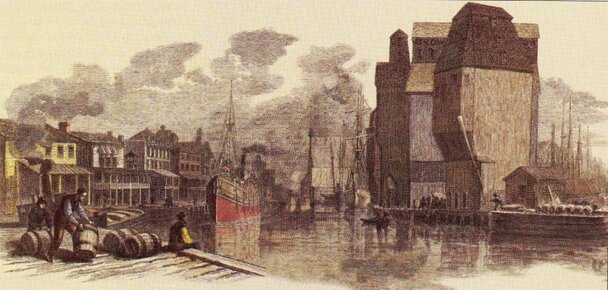
HARPERS WEEKLY 1877: The Central Wharf was known the world over as the business center of the grain trade. This widely published view shows some of the huge wooden grain elevators that were located opposite the Wharf.
Courtesy Donald I. Dussing, Jr.
In his “Recollections of Buffalo” published in 1891, Samuel Welch quotes his own article written shortly after the demise of the Central Wharf: "…had there been a Lisbonian earthquake there which had swallowed up all the people and buildings? This used to be called ‘on the dock’ – but where are all the warehouses, the offices, and balconies of Central Wharf? Where are all those bright, busy members of those thrifty and celebrated firms that I remember of old? I recollect these old firms: Gelston & Evans; Pratt, Taylor & Co.; Sheldon Thompson & Co.; Joy & Webster; Norton, Carlisle & Co.; Townsend, Coit & Co.; Holt, Palmer & Co.; Daw & DeLong; Smith & Macy; Treat & Carter; Kinne, Peabody & Sawyer; Munger & Willard; A.R. Cobb & Co.; Kinne, Davis & Co.; Kimberly, Pease & Co.; Azel Hooker; Ward & Brace & Co.; Mahlon Kingman & Co.; Sizer, Brown & Co. I remember these and others, with their host of energetic gentlemanly clerks, embryo principals, who comprised most of the list of forwarding and commission merchants, who ranged our docks when this was an infant city. Put their names in print once more…”
The Board of Trade is still with us. It has evolved and descended into the present as the organization known as the “Buffalo Niagara Partnership.” In 1883, it moved into the new Merchants Exchange building built on Seneca Street, a fine work designed by Milton Beebe. The name was changed to the Chamber of Commerce. By 1907, they were building a new modern office building designed by E.B. Green called the Chamber of Commerce.
The history of the Central Wharf is an American story, a stirring and colorful high point of local history that has national importance: business history, transportation history, social history, emigration history and architectural history. The buildings are all long gone, as is the forwarding business and the many distinctive vessels and vehicles that were as much a part of the story as the buildings. The site of the Central Wharf is seeing life once more with the popularity of Canalside. One can only hope something of this rich history will be evoked by plans for a revitalized waterfront.




